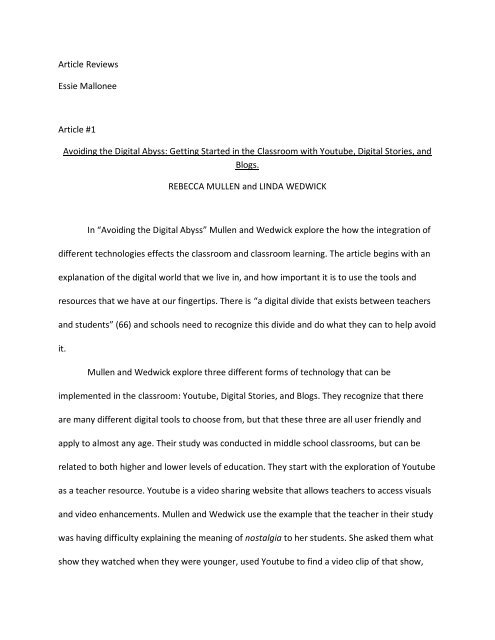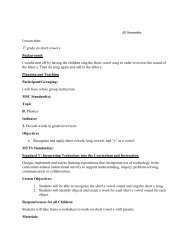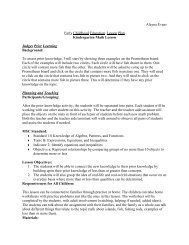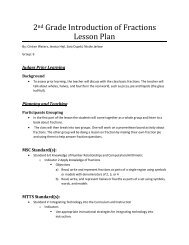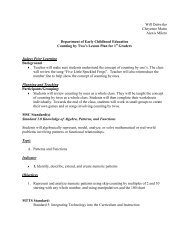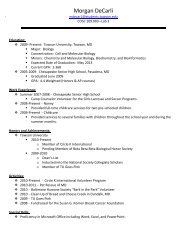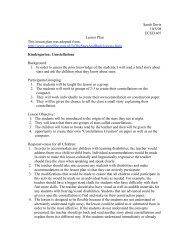Article Reviews Essie Mallonee Article #1 Avoiding the Digital Abyss ...
Article Reviews Essie Mallonee Article #1 Avoiding the Digital Abyss ...
Article Reviews Essie Mallonee Article #1 Avoiding the Digital Abyss ...
Create successful ePaper yourself
Turn your PDF publications into a flip-book with our unique Google optimized e-Paper software.
<strong>Article</strong> <strong>Reviews</strong><br />
<strong>Essie</strong> <strong>Mallonee</strong><br />
<strong>Article</strong> <strong>#1</strong><br />
<strong>Avoiding</strong> <strong>the</strong> <strong>Digital</strong> <strong>Abyss</strong>: Getting Started in <strong>the</strong> Classroom with Youtube, <strong>Digital</strong> Stories, and<br />
Blogs.<br />
REBECCA MULLEN and LINDA WEDWICK<br />
In “<strong>Avoiding</strong> <strong>the</strong> <strong>Digital</strong> <strong>Abyss</strong>” Mullen and Wedwick explore <strong>the</strong> how <strong>the</strong> integration of<br />
different technologies effects <strong>the</strong> classroom and classroom learning. The article begins with an<br />
explanation of <strong>the</strong> digital world that we live in, and how important it is to use <strong>the</strong> tools and<br />
resources that we have at our fingertips. There is “a digital divide that exists between teachers<br />
and students” (66) and schools need to recognize this divide and do what <strong>the</strong>y can to help avoid<br />
it.<br />
Mullen and Wedwick explore three different forms of technology that can be<br />
implemented in <strong>the</strong> classroom: Youtube, <strong>Digital</strong> Stories, and Blogs. They recognize that <strong>the</strong>re<br />
are many different digital tools to choose from, but that <strong>the</strong>se three are all user friendly and<br />
apply to almost any age. Their study was conducted in middle school classrooms, but can be<br />
related to both higher and lower levels of education. They start with <strong>the</strong> exploration of Youtube<br />
as a teacher resource. Youtube is a video sharing website that allows teachers to access visuals<br />
and video enhancements. Mullen and Wedwick use <strong>the</strong> example that <strong>the</strong> teacher in <strong>the</strong>ir study<br />
was having difficulty explaining <strong>the</strong> meaning of nostalgia to her students. She asked <strong>the</strong>m what<br />
show <strong>the</strong>y watched when <strong>the</strong>y were younger, used Youtube to find a video clip of that show,
and <strong>the</strong> children began reminiscing about when <strong>the</strong>y were younger and how much <strong>the</strong>y<br />
enjoyed that show. Thus she was able to spontaneously reinforce <strong>the</strong> meaning of a vocabulary<br />
word through <strong>the</strong> use of technology. The problem that you run into with this kind of resource is<br />
that it can be taken advantage of. Many schools, mine included, ban <strong>the</strong> use of Youtube<br />
because of <strong>the</strong> abundance of inappropriate material. This should not be <strong>the</strong> answer, <strong>the</strong>re<br />
needs to be a way that teachers and students can use resources like this one.<br />
The second mode of technology that <strong>the</strong>y examined was <strong>Digital</strong> Stories. The students<br />
used <strong>Digital</strong> Stories in replacement of writing assignments. They were still doing <strong>the</strong> same<br />
amount of work, still had to do <strong>the</strong> research and <strong>the</strong> writing, but <strong>the</strong> end product was a movie<br />
instead of a final paper. Because of <strong>the</strong> freedom that movie making provides, <strong>the</strong> students get<br />
to individualize <strong>the</strong>ir assignments, and take more pride in <strong>the</strong>ir finish product than <strong>the</strong>y would if<br />
<strong>the</strong>y were simply writing a paper.<br />
The last forum that Mullen and Wedwick discuss is <strong>the</strong> use of Blogs. According to<br />
Merriam-Webster (2008) blogs are “a Web site that contains an online personal journal with<br />
reflections, comments, and often hyperlinks provided by <strong>the</strong> writer” (69). Blogs are mostly<br />
used as a communication tool. It is especially useful for group activities so that results and<br />
comments as a group can be posted in one place.<br />
They conclude by reminding us that we live in a <strong>Digital</strong> world, and students need to be<br />
taught how to use <strong>the</strong>ir technology to gain certain skills that will help <strong>the</strong>m in <strong>the</strong>ir future<br />
endeavors. These three mediums are all easy and simple ways that teachers can integrate<br />
technology into <strong>the</strong>ir classroom learning to enhance <strong>the</strong> learning experience.
<strong>Article</strong> #2<br />
Classroom Blogging: What is <strong>the</strong> Role in Science Learning?<br />
ALISON SAWMILLER<br />
In “Classroom Blogging” Sawmiller explores how <strong>the</strong> use of blogs enhances <strong>the</strong><br />
experience that students have in <strong>the</strong> classroom, and more specifically in science learning. She<br />
begins by explaining <strong>the</strong> need for new technologies, such as blogs, in classrooms. She<br />
acknowledges that <strong>the</strong> main problem is that “At home, students read and write electronically,<br />
using computers, iPods, and kindles. In <strong>the</strong> classroom students read and write almost<br />
exclusively on paper.” (44) Students at home are learning in this new digital age, while <strong>the</strong><br />
institutions where <strong>the</strong>y are in <strong>the</strong> classroom have not caught up with societies technologies,<br />
and are much slower to change <strong>the</strong>ir ways.<br />
Sawmiller looks at <strong>the</strong> use of Blogs in science as a new way to do journal writing. These<br />
journals are used to develop critical thinking skills, involving problem solving and self-reflection.<br />
The most important aspect of <strong>the</strong> blog is that it can appeal to almost every style of learning.<br />
“Students may be better visual, auditory, kines<strong>the</strong>tic, social, logical, verbal, or solitary learners.<br />
The best lessons are <strong>the</strong> ones that embrace <strong>the</strong> most styles of learning.” (46) The blog offers<br />
ways to incorporate each style of learning, whe<strong>the</strong>r it is through pictures, podcasts, journal<br />
writing, or conducting experiments. That way it is much easier to reach and try to relate with all<br />
different kinds of students.<br />
Although this study was primarily looking at a science classroom, <strong>the</strong> values of using a<br />
blog can easily translate to many o<strong>the</strong>r arenas of learning. You can take <strong>the</strong> findings that she
had in her study and relate it to all different ages and subjects. This is an important technology<br />
because it can be used anywhere. There are many different factors that could limit <strong>the</strong> amount<br />
of time that students have in <strong>the</strong> classroom (Snow, flu epidemic, o<strong>the</strong>r illness etc.) and this<br />
provides a forum for learning that can occur outside classroom walls. As long as a student has<br />
access to <strong>the</strong> internet <strong>the</strong>y can upload data and information to <strong>the</strong>ir blog and can stay in touch<br />
with o<strong>the</strong>r classmates and <strong>the</strong> teacher.<br />
<strong>Article</strong> #3<br />
Why Do Teachers Not Practice What They Believe Regarding Technology Integration?<br />
CHAO-HSIU CHEN<br />
This article explores a different aspect to technology in <strong>the</strong> classrooms, and that is why<br />
it is not implemented by <strong>the</strong> teachers. The study takes place in Taiwan, but <strong>the</strong> results can be<br />
related to schools all over <strong>the</strong> world. Chen first had teachers show <strong>the</strong>ir beliefs to specific<br />
questions pertaining to constructivist instruction, and <strong>the</strong>n observed classroom activities to see<br />
if <strong>the</strong> beliefs matched up with classroom implementation. He found that although many<br />
teachers believe that technology is important to learning, and that it should be implemented in<br />
<strong>the</strong> classroom, teachers often do not or are not able to act accordingly.<br />
There were many different aspects that restricted teachers from using technology in<br />
<strong>the</strong>ir classrooms. First <strong>the</strong>re were logistical problems. Many schools do not have <strong>the</strong> resources<br />
available. There aren’t enough computers, or <strong>the</strong> schedule is set up so that <strong>the</strong>re isn’t enough
time to get to <strong>the</strong> lab. In Taiwan, <strong>the</strong> teachers do not have <strong>the</strong>ir own classrooms, but ra<strong>the</strong>r<br />
rotate to meet <strong>the</strong> students, which cause <strong>the</strong>m to not be as comfortable with <strong>the</strong>ir<br />
surroundings. Ano<strong>the</strong>r aspect that restricted <strong>the</strong>ir technology use was outside influences and<br />
pressures. Pressures from parents for <strong>the</strong>ir children to do well on tests make <strong>the</strong> teachers feel<br />
obligated to only teach what will make <strong>the</strong>m successful on <strong>the</strong> tests. These factors are fairly<br />
specific to Taiwan and <strong>the</strong> school that Chen was evaluating, but can be related to ones that we<br />
have in our own schools. Parents put a great deal of pressure on administration to teach <strong>the</strong>ir<br />
children what <strong>the</strong>y think is necessary. Therefore it is often difficult to implement something<br />
new without receiving complaint.<br />
Ano<strong>the</strong>r important aspect was that teachers are often not comfortable with <strong>the</strong><br />
technology itself. It is up to <strong>the</strong> administration to train teachers in <strong>the</strong>se newer technologies so<br />
that <strong>the</strong>y may feel comfortable using <strong>the</strong>m in <strong>the</strong>ir classrooms. This can easily be related to<br />
schools that we teach in, because all teachers need to be confident in what <strong>the</strong>y are teaching.<br />
So many of <strong>the</strong>se new tools are foreign to teachers, and <strong>the</strong>y take time to get used to and feel<br />
comfortable with. There needs to be time built in to helping teachers get familiar with new<br />
technologies, and <strong>the</strong> reasoning behind needing to use <strong>the</strong>m.<br />
<strong>Article</strong> #4<br />
Beyond Technology for Technology’s Sake: Advancing Multiliteracies in <strong>the</strong> Twenty-First<br />
Century<br />
CARLIN BORSHEIM, KELLY MERRITT, and DAWN REED
Borsheim, Merritt, and Reed explore <strong>the</strong> need to prepare and motivate students with<br />
multiliteracies. Multiliteracies is “based on <strong>the</strong> well-established assumption that technologies<br />
(including computers, cell phones, PDA’s, <strong>the</strong> Internet, and Web 2.0 applications such as wikis,<br />
blogs, and o<strong>the</strong>r social networking sites) have impacted <strong>the</strong> nature of texts, as well as <strong>the</strong> way<br />
people use and interact with texts.” (87) Using this teachers need to help students understand<br />
different media as well as why different technologies would be used for different purposes.<br />
There are many different reasons to use technology. Borsheim points out that using<br />
media can increase <strong>the</strong> audience. Whereas a traditional paper will be read by <strong>the</strong> professor and<br />
few o<strong>the</strong>rs, using <strong>the</strong> media can help to broaden <strong>the</strong> audience which in turn forces <strong>the</strong> student<br />
to take more time and pride in <strong>the</strong>ir work. Reed noticed this in her speech classroom as well.<br />
Instead of just having <strong>the</strong> students write and recite <strong>the</strong>ir speeches, she used podcasts and<br />
posted <strong>the</strong>m to blogs so that <strong>the</strong>y could reach members of <strong>the</strong> community as well as o<strong>the</strong>r<br />
classrooms around <strong>the</strong> world. This increase in audience made <strong>the</strong> students take more time in<br />
<strong>the</strong>ir projects and go through countless revisions, because <strong>the</strong>y wanted <strong>the</strong>ir message to be<br />
heard and <strong>the</strong>y wanted to be proud of what <strong>the</strong>y were accomplishing.<br />
Merritt discusses <strong>the</strong> use of technology not just to teach students, but also as a teaching<br />
tool for o<strong>the</strong>r teachers. She describes <strong>the</strong> use of wikispace as a place for teachers to collaborate<br />
and discuss ideas. So not only are teachers using technology to better help <strong>the</strong>ir students, but it<br />
can be used as a forum to help o<strong>the</strong>r teachers as well. It also bridges <strong>the</strong> distance gap. There<br />
could be a teacher doing exceptional things with technology in California, and through<br />
wikispace can be teaching exactly what <strong>the</strong>y are doing to teachers in Baltimore, eliminating <strong>the</strong>
cost and time of going to a conference, it can be done digitally. The same can be said for<br />
teachings around <strong>the</strong> world, not just in <strong>the</strong> United States, but all over <strong>the</strong> globe.<br />
<strong>Article</strong> Review #5<br />
Redefining Rigor: Critical Engagement, <strong>Digital</strong> Media, and <strong>the</strong> New English/Language Arts<br />
Jessica Dockter, Delania Haug, Cynthia Lewis<br />
In this article, Dockter, Haug, and Lewis explore implementing media-focused<br />
curriculum. They had a number of goals that <strong>the</strong>y wanted to achieve through this new format.<br />
They used responses that students had from taking a documentary film course, but <strong>the</strong><br />
objectives could be related to a number of different subjects.<br />
The first was to “allow students build <strong>the</strong>ir own understandings.” (419) Students need to<br />
be allowed to explore and come to <strong>the</strong>ir own conclusions, ra<strong>the</strong>r than just accepting<br />
preconceived notions. The second was to “allow students to collaborate in meaningful ways”<br />
(419) They use <strong>the</strong> example of students making podcasts about subjects that were important to<br />
<strong>the</strong>m. Discussing <strong>the</strong> podcasts encourages <strong>the</strong> students to have meaningful discussions with<br />
one ano<strong>the</strong>r, and to really learn something about each o<strong>the</strong>r because <strong>the</strong>ir learning about what<br />
<strong>the</strong>y’re all interested in. The third goal was to “include au<strong>the</strong>ntic audiences and consequences”<br />
(419) Just like a lot of <strong>the</strong> o<strong>the</strong>r articles have said, when you increase <strong>the</strong> audience size with <strong>the</strong><br />
use of technology, it forces to student to care more about <strong>the</strong> quality of <strong>the</strong>ir work. They take<br />
more pride in what <strong>the</strong>y are doing because <strong>the</strong>y are sharing it with more than just a teacher.
The last goal was to “encourage critical and creative thinking through a high degree of rigor”<br />
(419) They mention that <strong>the</strong> students not only had to critically analyze media but <strong>the</strong>y <strong>the</strong>n had<br />
to produce <strong>the</strong>ir own film. This caused <strong>the</strong>m to be more aware of what <strong>the</strong>y were producing<br />
and sharing with <strong>the</strong> world.<br />
The students’ response to this project was a positive one. They felt that this was <strong>the</strong><br />
most intellectually challenging course, <strong>the</strong> hardest work <strong>the</strong>y had, but also it was something<br />
that <strong>the</strong>y were proud of and <strong>the</strong>y felt respected and more connected with <strong>the</strong>ir communities.<br />
Although this relates more to <strong>the</strong> higher education of middle and upper school grades, it can<br />
also be related to early education. Having students do simple research projects in science or<br />
social studies, and <strong>the</strong>n using podcast or digital stories to publish <strong>the</strong>ir findings, uploading it to<br />
a blog or website so that family and friends can see <strong>the</strong> finished product could result in <strong>the</strong><br />
same feelings of pride and accomplishment that Dockter, Haug, and Lewis found with <strong>the</strong>ir<br />
students.<br />
References:<br />
Mullen, R., & Wedwick, L. (2008). <strong>Avoiding</strong> <strong>the</strong> <strong>Digital</strong> <strong>Abyss</strong>: Getting Started in <strong>the</strong> Classroom<br />
with Youtube, <strong>Digital</strong> Stories, and Blogs. The Clearing House, Vol. 82 Issue 2, p66-69<br />
Sawmiller, A. (2010). Classroom Blogging: What is <strong>the</strong> Role in Science Learning?.<br />
The Clearing House, 83: 44-48<br />
Chao-Hsiu, C. (2008). Why Do Teachers Not Practice What They Believe Regarding Technology<br />
Integration?. Journal of Educational Research, Vol 102 Issue 1, p65-75<br />
Borsheim, C., Merritt, K, & Reed, D. (2008). Beyond Technology for Technology’s Sake:<br />
Advancing Multiliteracies in <strong>the</strong> Twenty-First Century. The Clearing House, Vol 82 Issue 2, p87-<br />
90
Dockter, J., Haug, D., & Lewis, C. (2010). Redefining Rigor: Critical Engagement, <strong>Digital</strong> Media,<br />
and <strong>the</strong> New English/Language Arts. Journal of Adolescent & Adult Literacy, Vol 53 Issue 5,<br />
p418-420


